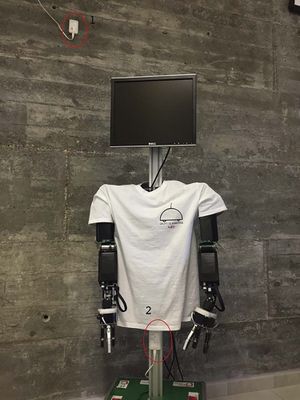Benchmark dataset for analysis of cyber-attacks to an indoor real time localization system for autonomous robots
This data report summarizes a benchmark dataset which can be used to analyze cyber-attacks to an indoor real time localization system for autonomous robots. Data have been gathered in an indoor mock-up apartment, shown in Fig 2 , located at the Robotics Lab of the University of León (Spain). An autonomous robot, called Karen and shown in Fig 1, with an on-board Real Time Location System (RTLS) was used to gather the data.
Further information can be found at: Guerrero-Higueras, Á. M., DeCastro-García, N., Rodríguez-Lera, F. J., & Matellán, V. (2017). Empirical analysis of cyber-attacks to an indoor real time localization system for autonomous robots. Computers & Security, 70, 422-435.
Contents
Materials
Data gathered by Karen robot include:
- Karen location estimates provided by a commercial RTLS, called KIO.
Additional information about Karen and the devices/packages used to get data is given below.
Karen robot
Fig. 1 shows the autonomous robot Karen, used in the experiments. Karen is a mobile manipulator built by the Robotics Group of the Universidad de León (Spain). It has two arms with 7 degrees of freedom, 3 fingers each, and a mobile base. The control of the robot is based on the Robot Operating System (ROS) framework.
KIO RTLS
KIO RTLS commercial solution by Eliko has been used to provide people location at the study area. Fig 1 shows a KIO beacon (1), and a KIO tag on the robot (2).
Recording procedure
Three different distributions of the KIO beacons were defined. Fig. 2 presents the experimental area map and shows the location of the beacons for the three cases. The red dots show the placement of the six beacons for Distribution #1, blue dots show the placement of the six beacons for Distribution #2, and green dots show the placement of the six beacons for Distribution #3. 12 checkpoints were determined in the experimental area. Karen was placed in all of them and the location estimates gathered by the tag were recorded for later analysis. Checkpoint locations are shown as black rounded numbered points in Fig. 2. There are nine checkpoints inside the mock up apartment to obtain location estimates in all rooms. Three other checkpoints are in the corridor for obtaining location estimates outside the mock up apartment.
cyber-attacks were performed on the beacons of KIO RTLS used by Karen robot in order to estimate its location. Two types of attacks were performed. The first one (A1i) simulated three DoS attacks, by interfering with the signal emitted by beacons 411A, 501C, and 408A, thus making it impossible for the tag to obtain distances from them. The DoS attack on beacon 411A is labeled A1a, the one on 501C, A1b, and the one on 501C, A1c.
The second type of attack (A2j) carried out four Spoofing attacks, changing the signal emitted by beacons 411A and 501C introducing either a fixed and a variable error, making the tag to calculate a wrong location. Spoofing attacks over the beacon 411A with either a fixed and variable error are labelled A2a and A2b respectively. The ones over 501C with either a fixed and variable error are labelled A2c and A2d respectively.
Data
Differents versions of the dataset are enumerated below.
